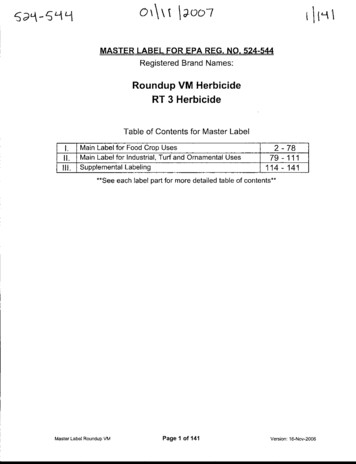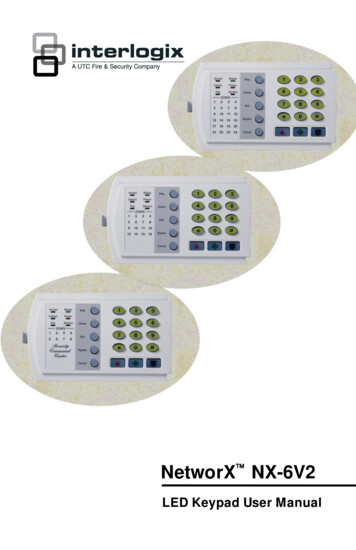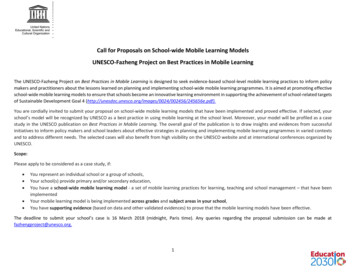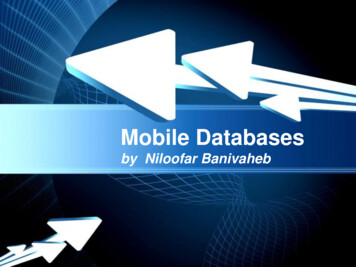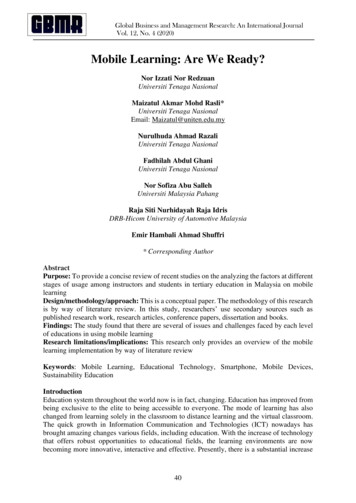
Transcription
Global Business and Management Research: An International JournalVol. 12, No. 4 (2020)Mobile Learning: Are We Ready?Nor Izzati Nor RedzuanUniversiti Tenaga NasionalMaizatul Akmar Mohd Rasli*Universiti Tenaga NasionalEmail: Maizatul@uniten.edu.myNurulhuda Ahmad RazaliUniversiti Tenaga NasionalFadhilah Abdul GhaniUniversiti Tenaga NasionalNor Sofiza Abu SallehUniversiti Malaysia PahangRaja Siti Nurhidayah Raja IdrisDRB-Hicom University of Automotive MalaysiaEmir Hambali Ahmad Shuffri* Corresponding AuthorAbstractPurpose: To provide a concise review of recent studies on the analyzing the factors at differentstages of usage among instructors and students in tertiary education in Malaysia on mobilelearningDesign/methodology/approach: This is a conceptual paper. The methodology of this researchis by way of literature review. In this study, researchers’ use secondary sources such aspublished research work, research articles, conference papers, dissertation and books.Findings: The study found that there are several of issues and challenges faced by each levelof educations in using mobile learningResearch limitations/implications: This research only provides an overview of the mobilelearning implementation by way of literature reviewKeywords: Mobile Learning, Educational Technology, Smartphone, Mobile Devices,Sustainability EducationIntroductionEducation system throughout the world now is in fact, changing. Education has improved frombeing exclusive to the elite to being accessible to everyone. The mode of learning has alsochanged from learning solely in the classroom to distance learning and the virtual classroom.The quick growth in Information Communication and Technologies (ICT) nowadays hasbrought amazing changes various fields, including education. With the increase of technologythat offers robust opportunities to educational fields, the learning environments are nowbecoming more innovative, interactive and effective. Presently, there is a substantial increase40
Global Business and Management Research: An International JournalVol. 12, No. 4 (2020)of technological utilization for educational purposes. With the potentials ICT offers,educational institutions are now seeking for new standards to restructure their educationalcurricula and classroom facilities to bridge the existing technology gap education. This processhowever requires effective acceptance of technologies into existing environment in order toprovide learners with the required knowledge as well as to promote meaningful learning(Tomei, 2005).An emerging paradigm in educational technology is mobile technologies, which mostlyreferred as mobile learning. Mobile learning has been defined differently by differentresearchers and organisations. A commonly accepted definition of mobile learning is usingmobile technologies to facilitate and promote learning anywhere and at any time (Hwang &Tsai, 2011; Shih, Chu, Hwang, & Kinshuk, 2010). Mobile learning (m-learning) is learningthrough wireless technological devices that can be pocketed and utilized wherever the learner’sdevice can receive unbroken transmission signals (Attewell and Savill-Smith, 2005). Ally(2009) defines Mobile Learning as the delivery of learning content to mobile devices.According to Kukulska-Hulme and Traxler (2005), “Mobile learning is partly about learningand partly about the breakthroughs of mobile computing and global mobile marketing ofmobile devices. It is rapidly becoming a credible and cost-effective component of online anddistance learning and anyone developing courses in companies, universities and colleges mustconsider carefully what it has to offer”. Simply defining, Wexler et al. (2007) refer to mobilelearning as “Any activity that allows individuals to be more productive when consuming,interacting with, or creating information, mediated through a compact digital portable devicethat the individual carries on a regular basis, has reliable connectivity, and fits in a pocket orpurse”. It refers to any learning which takes place via wireless mobile devices such as smartphones, PDAs, and tablet PCs where these devices are able to move with the learners to allowlearning anytime, anywhere (Naismith et al., 2006; Wang et al., 2009). The fast spread ofmobile devices and wireless networks within university campuses makes higher education asuitable place to integrate student-centered m-learning (Cheon et al., 2012). Mobile learningthat utilizes ubiquitous devices will be a successful approach now and in the future becausethese devices (PDA, tablet PC, smart phone) are more attractive among higher educationstudents for several reasons; one of them is that the mobile devices are cheaper compared withnormal PCs; also, they are satisfactory and economical tools (Mohamad et al., 2010). Mobiledevices have become more affordable, effective, and easy to use (Nassuora, 2012). Thesedevices can extend the benefits of e-learning systems (Motiwalla, 2007) by offering universitystudents opportunities to access teaching materials and ICT, learn in a collaborativeenvironment (Nassuora, 2012), and obtain formative evaluation and feedback from instructors(Crawford, 2007). M-learning can provide wireless communication between lecturers andstudents and between students themselves. It can work as additional support to complementand add value to existing learning models (Motiwalla, 2007). In addition, it is expected tobecome one of the most effective ways of delivering higher education materials in future (ElHussein & Cronje, 2010). Mobile learning implementation has to consider various educationalaspects, such as curriculum and pedagogy, institutional readiness, teacher competencies andlong-term financing (Tinio, 2003). To handle with such drastic changes in education, not onlystudents are expecting for supports of the new learning methodologies, teachers also need tobe furnished with the acquired literacy and skills on the new educational technology.There are several issues facing on the adoption of m-learning, and there are pedagogical issuesregarding the use of mobile devices in classrooms; will it disturb the learning process? (Corbeil& Valdes-Corbeil, 2007; Park, 2011). Also, will users (both students and lecturers) adopt thistechnology? Users may not be willing to accept m-learning (Wang et al., 2009). In addition,some university lecturers do not want to apply this technology or might face difficulties in41
Global Business and Management Research: An International JournalVol. 12, No. 4 (2020)trying to use it effectively as this new technology may require a lot of effort to implement (AbuAl-Aish et al., 2012). With the regards of these questions, this paper is to provide a concisereview of recent studies on the analyzing the factors at different stages of usage amonginstructors and students in tertiary education in Malaysia on mobile learning.Mobile learning is still beginning to take its first steps in colleges and universities in Malaysia.Although still at the initial stages, there were some studies that proved the potential of mobilelearning at higher education institutions in Malaysia. Ismail et al., (2010) conducted a researchto study the satisfaction of distance learners in university towards mobile learning and foundthat most respondents were satisfied with mobile learning, where they highly agreed thatmobile learning was helpful in assisting their learning process. Furthermore, Abas et al., (2009)also shown that the distance learners generally viewed mobile learning as beneficial, as well asbeing ready to embark on mobile learning. Most respondents agreed that mobile learning helpsthem to manage their time and be focus, flexible, motivated and interested in their learning(Abas et al., 2009). According to Keong et al., 2013 revealed that recent advancements intechnology have brought positive changes to the selection of a preferred path for learning inhigher education. Given technological innovations and the affordability of mobile devices,students are able to learn successfully through mobile learning and whenever respondents haveat least a smartphone or tablet shows that the university is ready for a larger scaleimplementation of mobile learning.Malaysian Government Initiatives towards Mobile LearningThe growth and usage of Internet has transform the education is delivered and conductedaround the globe. Malaysia has taken few steps ahead in recognizing the potential of thetechnology improving their education system. In 2011, National e-learning Policy (Dasar ePembelajaran Negara- DePAN) was launched by the Minister of Higher Education as a guidingprinciples for e-learning deployment among Malaysia higher education institutions (HEIs). ThePolicy is in line with the vision and mission of the Critical Agenda Projects (CAP) and theNational Key Result Areas (NKRA) by the Ministry of Higher Education. The purposed ofDePAN is for Malaysia HEIs to use the information communication technology to enhance thequality of teaching and learning. In order for these objective to take effect, a comprehensiveguideline called “E-Learning Guidelines for Malaysian HEIs” was introduced in 2014 by theMinistry of Higher Education in collaboration with the Malaysian Public Universities eLearning Council (MEIPTA). This guideline serve as a benchmark of good practices for theimplantation of e-Learning in Malaysia HEIs. DePAN 2.0 later introduced in 2015 to improvethe earlier plan. DePAN 2.0 is divided into three phase, Phase 1 (2015), Phase 2 (2016-2020)and Phase 3 (2021-2025). Unlike the early version of DePAN, DePan 2.0 emphasize on thequality and innovation in Malaysia education, branding, reduced the cost of expertise and inthe same time bringing Malaysian skills and professionals to the global standard.Realizing the important use of technology in today’s learning environment, Malaysiagovernment has taken an initiatives through the development of Malaysia Education Blueprint2013-2025 by highlighting the application of information communication technology (ICT) inMalaysia’s education system. One of the project is call “1BestariNet” where The Ministry ofEducation agreed to equip primary and secondary public schools in Malaysia with 4G internetaccess and a Virtual Learning Environment (VLE). To support this project, the ministry willensure that all teachers, instructors and trainer are high skilled and competent in the use ofVLE. Other than that, The Ministry also decided to boost online content to share best practicesstarting with a video library of the best teachers delivering lessons in Science, Mathematics,Bahasa Malaysia and English language. The government also decide to maximize use ofinformation communication technology for distance and self-pace learning to expand access to42
Global Business and Management Research: An International JournalVol. 12, No. 4 (2020)high-quality teaching regardless of the location or student skill level. All this initiative is toensure that Malaysia could move to a forefront of information communication innovation ineducation.With all the initiatives provided by Malaysia government it is clearly shows that Malaysia istaking mobile learning as a serious matters. Now, with an unprecedented pandemic where itforced the closure the schools and higher learning institutions including in Malaysia, mobilelearning has really only become common among Malaysia students where the connectivity,functionality via mobile device become the new normal.Issues and Challenges in Mobile LearningPre-schoolThe use of mobile learning is known as an instrument that can encourage the awareness andexperiences of preschool level and, from an educational perspective, help particular areas(Kokkalia, G., et al, 2016). But there some challenges raised up when using mobile learningfor preschool students.Firstly, children health from being exposed to the wireless gadget. According to Dr Zulkifli, thebest duration for those who are two to five years old, can be exposed that is around 30 minutesfor a period of two to three days once. If exceed the children will face weaken the child'simmune system if they are exposed to high radiation cause be exposed by radiation the beproduce by wireless gadget such as tablet and smartphones as study by the World HealthOrganization (WHO) (Alias, A. et al, 2015).Secondly, addictive toward wireless gadget (Kasnoon, K., 2016). This would also influencetheir way of thinking, most children who are only interested in a platform to be overwhelmedwith numerous exciting games. Many games restrict their creativity and imaginations and slowdown their motor and optical sensory development (Imafidon, C.,2015). Besides that, thechildren will face eye problem and had to wear glasses in early age because direct exposure toscreen light for a long time.Third, lack awareness and supportive of parents towards their child in education (UtusanBorneo, 2016). In past research, children be more learning development and tends to excelwhen their involvement of parents in studies (My Compass, 2020). But good involvement mayable to deliver good learning to their kids but there are also had irresponsible parents that givebad influenced to their child that such watch pornography (Azma ML ,2018). Theunappropriated content that can easily access through smartphones can give directly affect theirmental health and behaviour (Abdul A., N.A. et al, 2011; Alias, A. et al, 2015).Fourth, parents face extra financial pressure to cover the cost of financially sending their kidsto caregivers as kindergarten cannot operates as usual, and they also have to pay kindergartenfees at the same time to allow kids to participate in online learning (Abdul Manan, C., 2020).Lastly, mobile learning online is also not appropriate if the child is taken care of by a nannybecause of convenience factors such as the internet or necessary tools. Furthermore, childrenstudying online require guidance from adults, attention and assistance in the study process(Abdul Manan, C., 2020).Primary and Secondary SchoolThe use of smartphones is increasingly becoming a persuasive learning method used in distanceeducation to boost teaching and learning. Its use guarantees flexible delivery of courses,enables learners to access online learning channels, access course tools and connect digitally(Adjei N.D., 2019). Movement Control Order (MCO) that been issue by government givesignificant changes in Malaysia education which switch from physical classroom to virtual43
Global Business and Management Research: An International JournalVol. 12, No. 4 (2020)classroom (mobile learning) especially primary and secondary school. There are severalchallenges cause from these changes.Firstly, main challenge is the availability for access internet facilities. Students will need topurchase the latest software to access their online programs, or pay extra to upgrade to highspeed internet (Kementerian Sumber Manusia, 2020; Berita Harian, 2020). Besides that, theavailability and strength of signal internet access at rural area were very poor (Admin1, 2020)and the family situation to prepare the internet (Bernama1, 2020; Buang, S. & Lee, A.,2020).This may make it difficult for students who are less able to learn effectively due to thelack of internet access facilities compared to those who can afford all the software and highspeed internet .Furthermore, teacher had difficult to bring the best outcome and communicationdue to lack of internet problem (Berita Harian, 2020).Second, no computer or mobile phone facilities (Kementerian Sumber Manusia, 2020).According to study result of MOE, 36.9% of students nationwide do not have any electronicdevices (Berita Harian, 2020). For underprivileged students who do not have this gadgetfacility(Bernama1, 2020), it will make it difficult for them to pursue all the instructors' onlinelearning efforts and, in turn, cause them to be left behind compared to other peers (KementerianSumber Manusia, 2020; Buang, S. & Lee, A., 2020). Besides that, failure of technologicalequipment such as outdated smartphone model, cannot support some applications be use byteachers for online learning .Limited source technology cannot fullfill to big family membersthat still study in primary and secondary school which need them to share and take turn to use(Admin1, 2020)Third, an environment for learning which is not conducive to learning (Kementerian SumberManusia, 2020). When performing homework, students who underprivileged will certainlyface this problem. These issues involve a noisy setting, small rooms, and no tables and chairsthat are appropriate. Besides that, lack of parental support (Berita Harian, 2020; Admin1, 2020).The role of parents at home should changing, in specific role of parents whose children are stillin year one into year three. This student is certainly not capable of performing online tasks ontheir own (Berita Harian, 2020).Fourth challenge is learning effectiveness (Kementerian Sumber Manusia, 2020). Accordingteachers, student involve just around 30%-40%(Admin1, 2020). Online learning often does notdiscipline students and is reckless since the appropriateness of their time is contingent onlearning. Next, since they don't face to face and speak individually, the teacher won't know hisstudents' skill. During online presentations, contact is often not successful because internetspeeds cannot be very satisfactory (Kementerian Sumber Manusia, 2020; Berita Harian, 2020).Limited source technology also influences in learning effectivess because the lack of gadget tofullfill the big family members that still study in primary and secondary school which needthem to share and take turn to use (Admin1, 2020).Lastly, abuse of the internet (Kementerian Sumber Manusia, 2020). Since virtual learning isbased on the use of the internet, students would be exposed to various of true and false, goodand bad information that is exchanged through the internet. There is no doubt that so muchgood and positive information is accessible that students can use to develop their knowledgeand skills. However, there are many things that can be neglected and fun, especially for youngpeople. Among them are games of various forms and can be downloaded for free, as well asonline chat that discusses useless things such as gossip, entertainment and so on. If studentsare too preoccupied with the internet or internet addiction, it will have a negative impact onsocial relationships in society (Kementerian Sumber Manusia, 2020; Utusan Borneo, 2019)even can cause stroke and death (Agency, 2019).44
Global Business and Management Research: An International JournalVol. 12, No. 4 (2020)Tertiary educationThe closing of schools and higher education institutions, extended until April 14, in compliancewith the order of the Movement Control Order (PKP), will give educators new challenges toensure that their students will continue to learn (Bernama2, 2020). 27 May 2020, Minister ofEducation Malaysia (MOE) had issued “Pengajaran dan Pembelajaran” (PdP) to implementas online base learning until 31 december 2020 (Admin2, 2020).According Al-Hunaiyyan, A., Al-Sharhan, S., & Alhajri, R.,(2017), in the processimplementation of mobile learning programmes, one of the most significant issues facing higheducational institutions is the management of transition within the organisation. Managing suchchanges would impact the procedures, operations and components of the educationalorganisation, as well as individuals such as administrators, decision-makers, content designersand creators, staffs, students and instructors. Especially teaching staff, cause in order to supporttheir delivery, they need to specify the requirements, audience, resources and digitalinfrastructure (Mustapha, R., 2020).Secondly, there had limitation in hands-on. Cause, online assignment or learning anduniversities intend to hold lectures online until the end of the year. Since, computer-mediatedcommunication is seen to be less productive because it lacks body language, facial expressionand speech said student statement from English Literary Studies at the International IslamicUniversity of Malaysia, (Rafidi, R., 2020; University of Illinois Springfield, 2020). Especially,students who require clinical practise, practical training, laboratory, workshop, design studioor need special equipment for complete their certificate, diploma or bachelor's degree studies(Admin2, 2020).Third, lecturer commitment toward online education. According Nabilah Syafiqah SulaimanUniversiti Teknologi Malaysia Bachelor of Education Technology (mechanical engineering)student, the support of lecturers is crucial to online learning. They are constantly asking aboutour ability to attend their classes and systematically assign assignments. But there are a fewlecturers who do not pay much attention to students and only delegate work to be submitted oncertain dates, (Rafidi, R., 2020).Fourth, according to several international studies have found that between 0.7 percent to 27.5percent is the percentage of online video game addiction. In Asian countries and among menbetween the ages of 12 and 20 years, the proportion of online video game addiction is estimatedto be higher. Students will devote longer time for online video games to the incentives of freeinternet usage by telecommunications companies in PKP season. Students may become soabsorbed in playing that they forget to eat, study and sleep. If played in abundance, video gamesmay have harmful effects for student wellbeing and video game addiction or gaming disorderhas been identified as a mental health concern by the World Health Organization (WHO)(Mohd Sidik, S., 2020). Besides that, the drastic changes in environment of study make thestudent be more stress. Cause some of them be in campus or home for too long until theuniversities had to provide online counselling (Dolah Aling, Y., 2020)Lastly, the adaption and readiness of students. According Kellin Wong, chairman of the studentrepresentative council of Universiti Malaysia Sabah (UMS), noted that online teachingmethods or e-learning are generally already in place and used in public universities everysemester, but said some problems would emerge from a complete move to online learning.Maybe due to a lack of self-discipline or because they prefer face-to - face instruction, somestudents can lack motivation and have less interest in following through with lessons conductedonline. There is a real internet coverage problem, especially for students living in rural areas inSabah, noting that the line is very poor and that it would be difficult to reach them by phone(Lim, I., 2020). So, they had miscommunication during online learning and effect their studies(Sani, R., 2020).45
Global Business and Management Research: An International JournalVol. 12, No. 4 (2020)Strategies for Success in Mobile LearningAs can be seen from the discussion above, despite of all issues and challenges faced by higheror educational institutions in implementing mobile learning, there are a few studies which haveactively assessed the critical success strategies in mobile learning. Table below summarized onthe strategies:AuthorsAlrasheedi M. & Capretz LF.Year2018Andrews et. al2010Vlad Krotov2015Naish R.2005Guralnick D.2008Naismith & Corlett2006Gyeung-Min & Soo Min2005Delone & McLean2003Strategies for success in mobile learningDepends on the views of the users; goodcontent and user friendly design of the contentare essential to learners.Technologies such as podcasts and vodcastsare viewed as useful ways of expanding accessto teaching and learning activities in highereducation in a sustainable manner.Three areas to be focused on for mobilelearning success strategies which are:(1) The technology behind mobilelearning,(2) Managing individual differences andperceptions of people involved, and(3) The pedagogy behind mobile learningTechnologies behind mobile learning shouldbe standardized to ensure that it operatessmoothly.Developers of mobile learning must take intoaccount the environment in which theapplications will be used.There are five critical success strategies:(1) Access to technology(2) Ownership(3) Connectivity(4) Integration(5) Institutional supportAll academic institutions introducing mobilelearning methods should focus on systemquality, content quality and service quality.Assumes that the system quality, informationquality and service quality of the mobilelearning technology will affect its users’perceived usefulness and ease of use.Discussion and ConclusionIn conclusion, mobile learning is a part of educational system in today’s world and has a greatpotential to facilitate sustainability education. In a few years’ time, a smartphone could be theonly computer that used by majority of people. Mobile learning is easier as people can learnwhatever they want anytime, anywhere. People also can save time, energy and money as theycan learn at home, office and even during travelling. Even though there might be certain issues46
Global Business and Management Research: An International JournalVol. 12, No. 4 (2020)and challenges to be deal with, but, the ease of implementation for mobile learning can enhancelearner engagement and interaction.AcknowledgementThe authors would like to express our deepest gratitude to all members who have involveddirectly or indirectly in this research. Thanks to University Tenaga Nasional (UNITEN), iRMCfor awarding BOLD Grant 2020 (RJO10517844/028) to fund this study.ReferencesAbdul A., N.A. and Saari, C.Z. (2011), Menangani Permasalahan Laman Web Pornografi:Antara Perisian Penapis, Penguatkuasaan Undang-Undang Dan Amalan Spritual.Journal of Islamic and Arabic Education 3(1), 20111 29-46 retrieve l Manan, C. (2020), Kepentingan Tadika Dalam Budaya Kerja Norma Baharu. ww.bernama.com/bm/tintaminda/news.php?id 1847393Abu-Al-Aish, A., Love, S., & Hunaiti, Z. (2012). Mathematics students’ readiness for mobilelearning. International Journal of Mobile and Blended Learning (IJMBL), 4(4), 1-20.Abas, Z. W., Peng, C. L., & Mansor, N. (2009, February). A study on learner readiness formobile learning at Open University Malaysia. In IADIS International Conference MobileLearning (pp. 151-157).Adjei N.D. (2019), The Use And Effect Of Smartphones In Students’ Learning Activities:Evidence From The University Of Ghana, Legon. Library Philosophy and Practice iewcontent.cgi?article 6260&context libphilprac1Admin (2020), 'Sambutan Kelas Melalui Portal Online Tak Hangat' - Guru Ini Beri SemangatBuat Semua Cikgu. Retrieve in 2020, 13 August from Gps Bestari 48Admin2 (2020), Sesi Pengajaran Dan Pembelajaran Dilakukan Secara Online Sehingga 31Disember 2020 – KPT. Retrieve in 2020, 13 August from Pendidikan4All ara-online-hingga-31-disember/Agency (2019), Remaja Ketagih Main 'Game' Meninggal Dunia Akibat Strok. Retrieve in2020, 13 August from Astro Awani Online: l-Hunaiyyan, A., Al-Sharhan, S., & Alhajri, R. (2017). A New Mobile Learning Model in theContext of the Smart Classrooms Environment: A Holistic Approach. 3.6186Alias, A. and Parzi, M.N (2015), Gajet Lemahkan Imunisasi Kanak-Kanak. Retrieve in 2020,13 August from Berita Harian Online: /gajet-lemahkan-imunisasi-kanak-kanakAlrasheedi, M. & Capretz LF. (2015). Determination of critical success factors affectingmobile learning: a meta-analysis approach. Turkish Online Journal of EducationalTechnology, 41-51Andrews, T., Smyth, R., Tynan, B., Berriman, A., Vale, D., & Cladine, R. (2010). Mobiletechnologies and rich media: expanding tertiary education opportunities in developingcountries. In A. G. Abdel-Wahab, & A. A. El-Masry, Mobile Information47
Global Business and Management Research: An International JournalVol. 12, No. 4 (2020)Communication Technologies Adoption in Developing Countries: Effects andImplication. New York: Idea Group Inc.Attewell, J., & Savill-Smith, C. (2005). Mobile learning: reaching hard-to-reach learners andbridging the digital device. Methods and Technologies for learning, 361-365.Azma ML (2018), Kanak-Kanak 6 Tahun Ketagih Pornografi Hingga Bawa Telefon Pintar KeTadika Betapa Tenatnya Masyarakat Kita. Retrieve in 2020, 13 August from Pa&MaOnline: a-betapa-tenatnya-masyarakat-kita/Berita Harian (2020), Sedia Hadapi Kelas Maya Sesuai Normal Baharu. Retrieve in 2020, i-kelasmaya-sesuai-normal-baharuBernama1 (2020), Akses Internet Terhad Antara Cabaran Belajar, Mengajar Dalam ian/Bernama2 (2020), Cabaran Mengajar Dalam Talian. Retrieve in 2020, 13 August from SinarHarian g, S. & Lee, A. (2020), Jangankan Nak Beli Data, Makan Pun Susah, Keluh Ibu. s://www.malaysiakini.com/news/520468Cheon, J., Lee, S., Crooks, S. M., & Song, J. (2012). An investigation of mobile learningreadiness in higher education based on the theory of planned behavior. Computers &education, 59(3), 1054-1064.Corbeil, J. R., & Valdes-Corbeil, M. E. (2007). A
Mobile learning has been defined differently by different researchers and organisations. A commonly accepted definition of mobile learning is using mobile technologies to facilitate and promote learning anywhere and at any time (Hwang & Tsai, 2011; Shih, Chu, Hwang, & Kinshuk, 2010). Mobile learning (m-learning) is learning



